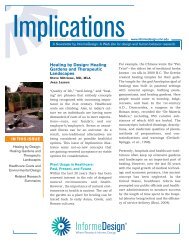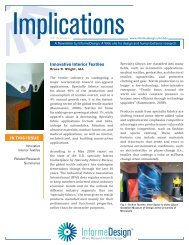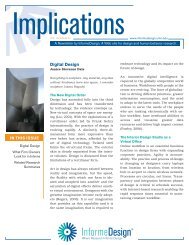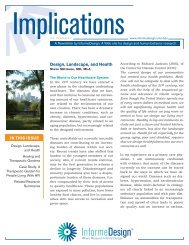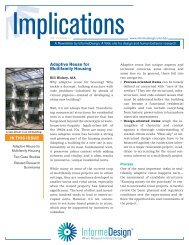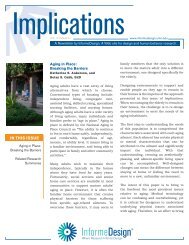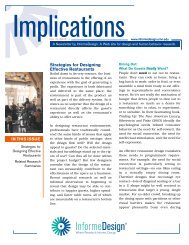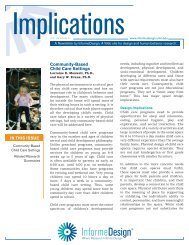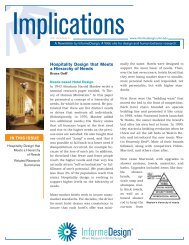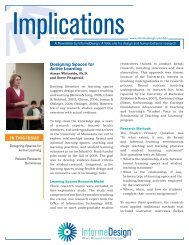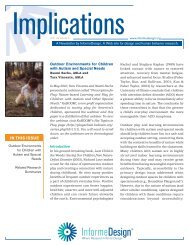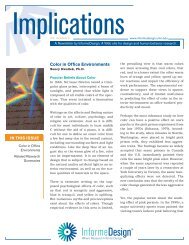Shopping Behaviors: Implications for the Design of ... - InformeDesign
Shopping Behaviors: Implications for the Design of ... - InformeDesign
Shopping Behaviors: Implications for the Design of ... - InformeDesign
Create successful ePaper yourself
Turn your PDF publications into a flip-book with our unique Google optimized e-Paper software.
<strong>Implications</strong><br />
A Newsletter by In<strong>for</strong>me<strong>Design</strong>. A Web site <strong>for</strong> design and human behavior research.<br />
IN THIS ISSUE<br />
<strong>Shopping</strong> Behavior:<br />
<strong>Implications</strong> <strong>for</strong> <strong>the</strong><br />
<strong>Design</strong> <strong>of</strong> Retail<br />
Spaces<br />
Working with a Retail<br />
Merchandiser<br />
Recent Retail Titles<br />
Related Research<br />
Summaries<br />
VOL. 02 ISSUE 05<br />
<strong>Shopping</strong> <strong>Behaviors</strong>:<br />
<strong>Implications</strong> <strong>for</strong> <strong>the</strong> <strong>Design</strong><br />
<strong>of</strong> Retail Spaces<br />
Do you or your retail clients ever wonder<br />
why customers leave retail stores empty<br />
handed? It may have something to do<br />
with <strong>the</strong> design <strong>of</strong> <strong>the</strong> space and location<br />
<strong>of</strong> <strong>the</strong> merchandise. If we consider how<br />
people shop, it may tell us something<br />
about how retail environments need to<br />
be designed to maximize customer purchasing.<br />
One individual concerned with<br />
understanding what motivates consumers<br />
to purchase in <strong>the</strong> marketplace<br />
is Paco Underhill. Underhill (1999) in his<br />
book, Why We Buy: The Science <strong>of</strong><br />
<strong>Shopping</strong>, makes several recommendations<br />
that have relevance to designers<br />
interested in planning and executing<br />
effective retail environments. Our goal is<br />
to share five <strong>of</strong> his recommendations<br />
that we believe are particularly important<br />
<strong>for</strong> designers to consider.<br />
Transition Zone<br />
Have you ever noticed when you are<br />
shopping and in a hurry that you find<br />
yourself in <strong>the</strong> middle <strong>of</strong> <strong>the</strong> store be<strong>for</strong>e<br />
you are able to slow down and take a<br />
look at <strong>the</strong> merchandise? Underhill<br />
noted that every store has a transition<br />
zone or area where customers begin to<br />
slow <strong>the</strong>ir pace and make <strong>the</strong> transition<br />
from being outside <strong>of</strong> <strong>the</strong> store to being<br />
www.in<strong>for</strong>medesign.umn.edu<br />
inside. He refers to this area as “<strong>the</strong><br />
shopper’s landing strip” (p.47). What is<br />
important about <strong>the</strong> transition zone is<br />
whatever is located in <strong>the</strong> zone is pretty<br />
much lost on customers. If <strong>the</strong>re is merchandise<br />
displayed in this area, customers<br />
are unlikely to see it.<br />
What does having a transition zone<br />
mean <strong>for</strong> design? For a big store, retailers<br />
can consider this space as waste and<br />
avoid placing or doing anything <strong>of</strong> importance<br />
<strong>the</strong>re. For a small store where<br />
space is at a premium, <strong>the</strong> goal is to keep<br />
<strong>the</strong> transition zone as small as possible.<br />
Perhaps <strong>the</strong> best strategy to shorten <strong>the</strong><br />
transition zone is to create a power display.<br />
A power display is a large, horizontal<br />
display that acts as a barrier. The<br />
barrier is intended to slow customers<br />
down sooner and speed up <strong>the</strong> transition<br />
from being outside to being inside <strong>the</strong><br />
store. Slowing <strong>the</strong> customer down sooner<br />
gives <strong>the</strong> customer time to absorb <strong>the</strong><br />
layout <strong>of</strong> <strong>the</strong> store and decide where to<br />
go.<br />
Chevroning<br />
The key to having customers purchase<br />
items is <strong>the</strong>ir ability to locate items in<br />
<strong>the</strong> store. Underhill recommends maximizing<br />
customers’ view <strong>of</strong> <strong>the</strong> merchandise<br />
by chevroning. Chevroning involves<br />
“placing shelves or racks at an angle”
<strong>Implications</strong><br />
instead <strong>of</strong> shelves being placed at <strong>the</strong> traditional<br />
ninety-degree angle to <strong>the</strong> aisle (p.79). The outcome<br />
<strong>of</strong> chevroning is that shelves are located at <strong>for</strong>ty-five<br />
degrees. As a result, more <strong>of</strong> what <strong>the</strong> shelves hold is<br />
exposed to <strong>the</strong> customers. The logic behind <strong>the</strong> recommendation<br />
is <strong>the</strong> more customers’ see, <strong>the</strong> more<br />
<strong>the</strong>y purchase. However, <strong>the</strong>re is a disadvantage to<br />
chevroning. The store can display only 80% <strong>of</strong> <strong>the</strong><br />
merchandise that could be displayed using traditional<br />
methods. The question becomes: will you actually<br />
sell more by displaying less?<br />
The Butt-Brush Effect<br />
Each customer has an area <strong>of</strong> personal space. This is<br />
an area that when invaded causes customers to feel<br />
uncom<strong>for</strong>table. Personal space translated into a<br />
retail environment suggests that when a shopper is<br />
bumped or jostled while looking at merchandise,<br />
<strong>the</strong>y may become uncom<strong>for</strong>table, lose interest, and<br />
leave <strong>the</strong> area. Underhill notes that “irritated shoppers<br />
do not tarry; in fact, <strong>the</strong>y frequently leave be<strong>for</strong>e<br />
purchasing what <strong>the</strong>y came <strong>for</strong>” (p.117). Creating<br />
maneuvering room <strong>for</strong> customers eliminates or greatly<br />
reduces <strong>the</strong> butt-brush effect. More maneuvering<br />
room extends time customers spend in <strong>the</strong> store and<br />
enhances <strong>the</strong> probability <strong>of</strong> purchasing.<br />
Crate and Barrel creates maneuvering room with wide aisles<br />
Where Research In<strong>for</strong>ms <strong>Design</strong><br />
www.in<strong>for</strong>medesign.umn.edu<br />
Seating Area<br />
As retail merchandising<br />
faculty, we spend time<br />
in stores looking at how<br />
merchandise is displayed,<br />
how customers<br />
are treated, and how<br />
customers shop among<br />
o<strong>the</strong>r things. One <strong>of</strong> <strong>the</strong><br />
things we note is shopping<br />
tends to be a social<br />
activity. People like to<br />
shop with o<strong>the</strong>rs—<br />
whe<strong>the</strong>r friends, spouses,<br />
or o<strong>the</strong>r relatives. These shopping partners need<br />
a place to rest. “A chair says: we care” (p. 88). If shopping<br />
partners have a place to sit, most likely <strong>the</strong>y will<br />
not complain and shopping can continue <strong>for</strong> longer<br />
lengths <strong>of</strong> time! Underhill talked about <strong>the</strong> importance<br />
<strong>of</strong> where to place seating. Seating should be<br />
provided by <strong>the</strong> dressing rooms. In particular, in providing<br />
seating <strong>for</strong> male shopping companions <strong>the</strong><br />
store would want to keep seating away from areas<br />
that women feel are personal, <strong>for</strong> example, <strong>the</strong> lingerie<br />
section.<br />
Dressing Rooms<br />
Many retailers want to minimize <strong>the</strong> non-selling<br />
areas (e.g., storage) <strong>of</strong> <strong>the</strong>ir stores. Some apparel<br />
retailers make <strong>the</strong> mistake <strong>of</strong> assuming that a dressing<br />
room is a non-selling area. Underhill noted that<br />
many retailers “think <strong>of</strong> dressing rooms as bathrooms”<br />
(p.170). We agree with Underhill that dressing<br />
rooms are a huge selling tool. Retailers need to<br />
devote enough, time, money, or space on <strong>the</strong>ir dressing<br />
rooms. Dressing rooms are <strong>the</strong> location where<br />
most apparel buying decisions are made. Dressing<br />
rooms need lighting that is flattering, wall hooks and<br />
hangers <strong>for</strong> customers’ clo<strong>the</strong>s, and furnishings that<br />
entice <strong>the</strong>ir use. The mirrors should be large and first<br />
rate—“<strong>the</strong>y should look like <strong>the</strong> frame <strong>for</strong> a flattering<br />
2
<strong>Implications</strong><br />
portrait” (p.172). Dressing rooms must be clearly<br />
marked so that <strong>the</strong>y are easy to find. The longer <strong>the</strong><br />
customer has to look <strong>for</strong> a dressing room, <strong>the</strong> more<br />
likely <strong>the</strong>y will leave without making a purchase.<br />
Final Thoughts<br />
In addition to <strong>the</strong> recommendations that we have<br />
highlighted, any design decisions that involved signage,<br />
display, store layout, fixturing, and <strong>the</strong> like<br />
basically impact <strong>the</strong> store’s effectiveness as a com<strong>for</strong>table<br />
and enjoyable place to shop. It has been well<br />
established that <strong>the</strong> amount <strong>of</strong> time a customer<br />
spends in <strong>the</strong> store depends on how com<strong>for</strong>table <strong>the</strong>y<br />
are in <strong>the</strong> store. The longer <strong>the</strong> retailer can keep a<br />
customer in <strong>the</strong>ir store, <strong>the</strong> more <strong>the</strong> customer will<br />
buy. Hence, <strong>the</strong> three-dimensional design <strong>of</strong> <strong>the</strong><br />
retail environment plays a significant role in <strong>the</strong><br />
retailers’ success.<br />
Reference:<br />
—Underhill, P. (1999). Why we buy: The science <strong>of</strong><br />
shopping. New York: Touchstone.<br />
Working with a Retail Merchandiser<br />
Retail merchandisers are concerned with <strong>the</strong> planning<br />
required to have <strong>the</strong> right merchandise at <strong>the</strong><br />
right time in <strong>the</strong> right<br />
place in <strong>the</strong> right quantity<br />
at <strong>the</strong> right prices,<br />
and with <strong>the</strong> right sales<br />
promotion <strong>for</strong> targeting<br />
specific customers<br />
(Stone, 2004, p.4).<br />
Saavy designers interested<br />
in designing a<br />
successful retail space<br />
might consider incorporating<br />
a retail merchandiser<br />
as part <strong>of</strong> <strong>the</strong>ir<br />
design team—<strong>for</strong> a<br />
number <strong>of</strong> reasons.<br />
Where Research In<strong>for</strong>ms <strong>Design</strong><br />
www.in<strong>for</strong>medesign.umn.edu<br />
Perhaps <strong>the</strong> most important reason is that <strong>the</strong> merchandiser<br />
has in-depth knowledge <strong>of</strong> brands that are<br />
going to be featured in <strong>the</strong> store. Whe<strong>the</strong>r <strong>the</strong> store is<br />
going to carry several brands (e.g., JCPenny, Sears)<br />
or whe<strong>the</strong>r <strong>the</strong> store is an expression <strong>of</strong> a single<br />
brand (e.g., Gap, The<br />
Limited, Pottery Barn),<br />
retail merchandisers<br />
understand that managing<br />
<strong>the</strong> brand(s) is <strong>the</strong><br />
future <strong>of</strong> <strong>the</strong> store.<br />
A retail merchandiser<br />
can answer three key<br />
questions <strong>for</strong> designers<br />
that impact <strong>the</strong> design<br />
<strong>of</strong> <strong>the</strong> store.<br />
Question #1<br />
The first question is what brands will be featured in<br />
<strong>the</strong> store and how are those brands positioned? How<br />
a brand is positioned defines <strong>the</strong> way retailers want<br />
consumers to think about <strong>the</strong>m. In o<strong>the</strong>r words, <strong>the</strong><br />
retail merchandiser can share in<strong>for</strong>mation regarding<br />
which specific consumer groups <strong>the</strong> store is intended<br />
to engage and what differentiates this store from<br />
its competitors.<br />
Question #2<br />
The second question is what is <strong>the</strong> personality <strong>of</strong> <strong>the</strong><br />
brand(s) featured? Since a brand’s personality may<br />
be <strong>the</strong> one and only feature that separates it from <strong>the</strong><br />
competition, <strong>the</strong> designer needs to know <strong>the</strong> brand’s<br />
personality to convey it through <strong>the</strong> store’s design. Is<br />
this <strong>the</strong> fun brand? Is this <strong>the</strong> creative brand? Is this<br />
<strong>the</strong> mysterious brand?<br />
Question #3<br />
The final question is what are <strong>the</strong> brand’s affiliations?<br />
In o<strong>the</strong>r words, how do you want people to be<br />
perceived as a result <strong>of</strong> being known users <strong>of</strong> <strong>the</strong><br />
3
<strong>Implications</strong><br />
brand? What do you<br />
want o<strong>the</strong>rs to think<br />
about your customers?<br />
The answers to all <strong>of</strong><br />
<strong>the</strong>se questions must<br />
be addressed during <strong>the</strong><br />
initial discussions with<br />
<strong>the</strong> owners <strong>of</strong> <strong>the</strong> retail<br />
business and should<br />
<strong>for</strong>m <strong>the</strong> core <strong>of</strong> <strong>the</strong> programming<br />
discussions<br />
occurring during <strong>the</strong><br />
pre-design phase <strong>of</strong> <strong>the</strong> project. Without having an<br />
in-depth understanding <strong>of</strong> <strong>the</strong>se issues, <strong>the</strong> most<br />
aes<strong>the</strong>tically pleasing, innovative, or functional retail<br />
environment could still spell ruin <strong>for</strong> its owner.<br />
Answers to <strong>the</strong>se questions will enable <strong>the</strong> retail<br />
designer to design a space that supports <strong>the</strong> business<br />
needs <strong>of</strong> <strong>the</strong> owner by shaping <strong>the</strong> customers’<br />
experience. The experience and insights <strong>of</strong> retail merchandiser<br />
might just help ensure that happens.<br />
Reference:<br />
—Stone, E. (2004). The dynamics <strong>of</strong> fashion. New<br />
York: Fairchild Publications.<br />
About <strong>the</strong> Authors:<br />
Seung-Eun Lee, an Assistant Pr<strong>of</strong>essor <strong>of</strong> <strong>the</strong> retail<br />
merchandising program, joined <strong>the</strong> University <strong>of</strong><br />
Minnesota's faculty in 2002. She received her M.S.<br />
and Ph.D. from Iowa State University. Her research<br />
focuses on understanding <strong>the</strong> influence <strong>of</strong> new retailing<br />
technology on consumer shopping behavior and<br />
issues related to small independent retailing. Her<br />
articles have appeared in various pr<strong>of</strong>essional journals,<br />
including Clothing and Textiles Research<br />
Journal, European Journal <strong>of</strong> Marketing, International<br />
Review <strong>of</strong> Retail, Distribution and Consumer<br />
Research, Journal <strong>of</strong> Business Management, Journal<br />
<strong>of</strong> Fashion Marketing and Management, and Journal<br />
Where Research In<strong>for</strong>ms <strong>Design</strong><br />
www.in<strong>for</strong>medesign.umn.edu<br />
<strong>of</strong> Industrial Technology. Lee currently teaches multichannel<br />
retailing, retail promotion and consumer<br />
decision making, among o<strong>the</strong>r courses.<br />
Kim K. P. Johnson, Ph.D., is a Pr<strong>of</strong>essor in <strong>the</strong><br />
Department <strong>of</strong> <strong>Design</strong>, Housing, and Apparel. She<br />
serves as retail merchandising program chair. Her<br />
scholarship focuses on retail merchandising and <strong>the</strong><br />
socio-psychological aspects <strong>of</strong> clothing. She practices<br />
<strong>the</strong> integration <strong>of</strong> teaching, discovery, and outreach<br />
in such projects as “Small Store Survival Strategies”<br />
and “Effect <strong>of</strong> Teasing on Adolescent Development.”<br />
She serves as <strong>the</strong> editor <strong>of</strong> <strong>the</strong> Clothing and Textile<br />
Research Journal. She has co-edited three books—<br />
Dress and Identity, Appearance and Power, and<br />
Fashion Foundations and has several publications in<br />
<strong>the</strong> Family and Consumer Sciences Research Journal,<br />
Journal <strong>of</strong> Family and Consumer Sciences, Clothing<br />
and Textile Research Journal, and Journal <strong>of</strong> Fashion<br />
Marketing and Management, among o<strong>the</strong>rs. She is a<br />
Fellow <strong>of</strong> <strong>the</strong> International Textile and Apparel<br />
Association. Johnson received her Ph.D. and M.S.<br />
from <strong>the</strong> University <strong>of</strong> Wisconsin-Madison and her<br />
B.S. from <strong>the</strong> University <strong>of</strong> Wisconsin-Stevens Point.<br />
Seung-Eun Lee, Ph.D. (left) and Kim K. P. Johnson, Ph.D. (right)<br />
Recent Retail Titles<br />
According to Johnson and Lee, <strong>the</strong> following recently<br />
published books might be <strong>of</strong> interest to you if your<br />
practice or area <strong>of</strong> interest focuses on retail design:<br />
4
<strong>Implications</strong><br />
—Tucker, J. (2003). Retail Desire: <strong>Design</strong>, Display<br />
and Visual Merchandising. East Sussex, UK:<br />
Sheridan House.<br />
—Dean, C. (2003). The Inspired Retail Space.<br />
Gloucester, MA: Rockport Publishers.<br />
—Miller, D., Jackson, P., Thrift, N., Holbrook, B., &<br />
Rowlands, M. (1998). <strong>Shopping</strong>, Place, and Identity.<br />
London: Routledge.<br />
—Wrigley, N. (2002). Reading Retail: A Geographical<br />
Perspective on Retailing and Consumption Spaces.<br />
New York: Ox<strong>for</strong>d University Press.<br />
Related Research Summaries<br />
In<strong>for</strong>me<strong>Design</strong> has many Research Summaries about<br />
retail design and related, pertinent topics. This<br />
knowledge will be valuable to you as you consider<br />
your next design solution and worth sharing with<br />
your clients and collaborators.<br />
“Retail Area <strong>Design</strong> Influences <strong>Shopping</strong> Behavior”<br />
—Journal <strong>of</strong> Retailing and Consumer Services<br />
“Rise <strong>of</strong> Themed Flagship Stores”<br />
—Journal <strong>of</strong> Retailing<br />
“Consumers’ Attraction to Point-<strong>of</strong>-Purchase<br />
Displays”—International Journal <strong>of</strong> Consumer Studies<br />
“Why Teens Go to Malls”<br />
—Family and Consumer Sciences Research Journal<br />
“Wayfinding in <strong>Shopping</strong> Malls”<br />
—Environment and Behavior<br />
www.in<strong>for</strong>medesign.umn.edu<br />
“<strong>Design</strong>ing Retail Stores <strong>for</strong> Disabled People”<br />
—Journal <strong>of</strong> Retailing<br />
“Music and Scents Can Improve Retail Service”<br />
—Journal <strong>of</strong> Retailing<br />
“Consumer Perception <strong>of</strong> Store Image”<br />
—Journal <strong>of</strong> Retailing and Consumer Services<br />
“Scanner and Checkstand <strong>Design</strong> Can Influence<br />
Wrist Injury”—Human Factors<br />
Photos Courtesy <strong>of</strong>:<br />
Caitlyn Quinn (Crate and Barrel Interior, p. 2)<br />
Debbie Boyles, University <strong>of</strong> Minnesota (Lee and<br />
Johnson, p. 4)<br />
Caren Martin, University <strong>of</strong> Minnesota (remainder)<br />
The Mission<br />
Created by: Sponsored by:<br />
The Mission <strong>of</strong> In<strong>for</strong>me<strong>Design</strong> is to facilitate interior<br />
designers’ use <strong>of</strong> current, research-based in<strong>for</strong>mation as<br />
a decision-making tool in <strong>the</strong> design process, <strong>the</strong>reby<br />
integrating research and practice.<br />
5




